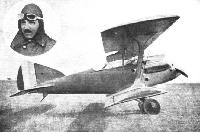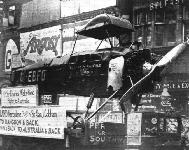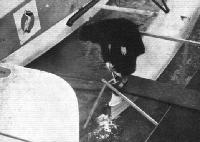Фотографии
-
A Record Breaker: The Bleriot-Spad, with 450 h.p. Lorraine-Dietrich engine, on which the French pilot, Jean Callizo, made a world's record altitude flight of 12,442m. (40,810 ft.) on August 23. This flight, which lasted 2 hrs. 25 mins., thus beat his previous record of 12,066 m. (40,783 ft.) created on October 10, 1924.
Самолёты на фотографии: Bleriot-SPAD S.61 - Франция - 1923
-
Регистрационный номер: G-EBFO In the Lord Mayor's Show: Sir Alan Cobham's de Havilland 50J, with Armstrong-Siddeley "Jaguar" engine, in which he flew to Cape Town and back and to Australia and back, formed part of this year's procession.
Самолёты на фотографии: De Havilland D.H.50 - Великобритания - 1923
-
Регистрационный номер: G-EBOP [2] CHRISTENING THE "PELICAN": Lady Ormsby-Gore breaking a bottle of champagne on the float of the D.H.50 seaplane which is going out to Africa.
Самолёты на фотографии: De Havilland D.H.50 - Великобритания - 1923
-
Регистрационный номер: G-EBOP [2] "A WONDERFUL BIRD IS THE PELICAN": Intended for use on the Khartum-Kenya air route, the first D.H.50 seaplane, with Bristol "Jupiter VI" engine, was tested on Monday last at Rochester by Capt. Broad. In the lower picture Broad is seen taking off from the mud, while above the machine is seen alighting and in flight. The inset shows Capt. Broad. The floats, made of Vickers Duralumin, were designed and built by Short Brothers.
Самолёты на фотографии: De Havilland D.H.50 - Великобритания - 1923
-
Регистрационный номер: J8049 AT THE CROYDON DEMONSTRATION LAST WEEK: Some of the single-seater fighters getting ready to leave for their "Home Stations."
Самолёты на фотографии: Armstrong Whitworth Siskin - Великобритания - 1921
-
STREAMLINING: A side view of the Macchi M.39 low-wing monoplane built for the Schneider Cup Race. The external wing bracing forms a letter N as regards the left bracing, while the landing wires are in the form of a letter A, the cross-stroke being formed by a short horizontal steadying strut or distance piece. The proportion of fixed vertical fin area to rudder area is large. The engine is a Fiat.
Самолёты на фотографии: Macchi M.39/M.52/M.67 - Италия - 1926
-
A CHALLENGER: This front view shows the Macchi M.39 Monoplane, with Fiat engine, designed and constructed for the forthcoming Schneider Cup Race in Virginia. That the lines are clean there can be no gainsaying. The fuselage is of small cross-sectional area, the wing bracing is a minimum, and the radiators are of the wing surface type. The machine has "speed" written all over it. Whether it will be able to defeat the American defenders remains to be seen.
Самолёты на фотографии: Macchi M.39/M.52/M.67 - Италия - 1926
-
Регистрационный номер: L-BONI WINNERS OF THE 1926 "COPPA D'ITALIA," AND PERMANENT HOLDERS OF THE CUP: On the left the "Avia" B.H.11, with 60 h.p. Walter engine, on which Bican won this year's competition. The group on the right includes Bican, pilot of the machine, Kinsky, his passenger, and Kopexky, Secretary of the Aero Club of Czechoslovakia.
Самолёты на фотографии: Avia BH-9 / BH-10 / BH-11 / BH-12 / BH-16 - Чехословакия - 1923
-
A 1,300-H.P. FLYING BOAT: This photograph shows the new Dornier "Super-Wal," fitted with two Rolls-Royce "Condor" engines, in flight over Lake Constance, where it recently underwent its first flying tests. This machine has seating accommodation for 21 passengers in two separate cabins. An idea of the size of the machine may be formed when it is pointed out that the wing span is 28-5 m. (93 ft. 6 in.) and the wing area 143 sq. m. (1,540 sq. ft.).
Самолёты на фотографии: Dornier Do.R Super Wal - Германия - 1926
-
Регистрационный номер: G-EBMW [3] THE DE HAVILLAND 66 "HERCULES": Fitted with three Bristol "Jupiter VI" engines this type of machine is intended for the Cairo-Karachi air route which is to come into operation early in 1927. The Secretary of State for Air, Sir Samuel Hoare, who will be accompanied by Lady Maud Hoare, will be one of the passengers in the first machine to fly out to the East. A detailed description, with general arrangement drawings and sketches of constructional details, was published in our issue of June 10, 1926.
Самолёты на фотографии: De Havilland Hercules / D.H.66 - Великобритания - 1926
-
Регистрационный номер: G-EBMW [3] THE CAIRO-KARACHI AIR ROUTE: Two aerial views of the de Havilland "Hercules," with three Bristol "Jupiter" engines, taken during a test flight in the neighbourhood of Stag Lane Aerodrome.
Самолёты на фотографии: De Havilland Hercules / D.H.66 - Великобритания - 1926
-
Регистрационный номер: G-EBMW [3] THE DE HAVILLAND 66 "HERCULES' : Side View. Note the three rudders and the biplane tail. The protruberance aft of the pilot's cockpit is the fresh-air intake for the cabin. Mounted next to it is the Bristol engine starter by means of which the three main Bristol "Jupiter" engines are started.
Самолёты на фотографии: De Havilland Hercules / D.H.66 - Великобритания - 1926
-
Регистрационный номер: G-EBNS AN INTERESTING THREE-ENGINED AEROPLANE: Four views of the Handley Page "Hamlet" (three Bristol "Lucifer" engines), which was illustrated and described in detail in our issue of October 14, 1926. In the three-quarter front view the leading edge slot is closed, while in the side view it is shown open.
Самолёты на фотографии: Handley Page Hamlet / H.P.32 - Великобритания - 1926
-
The Supermarine "Southampton" about to alight.
Самолёты на фотографии: Supermarine Southampton / Solent - Великобритания - 1925
-
The Supermarine "Southampton" in the air: This machine is capable of flying and manoeuvring with one of its Napier "Lion" engines stopped.
Самолёты на фотографии: Supermarine Southampton / Solent - Великобритания - 1925
-
THE SUPERMARINE "SOUTHAMPTON": Three-quarter front view of the machine on the slipway. This photograph also gives a good idea of the somewhat unusual arrangement of the interplane struts. The Napier "Lion" engines are mounted on struts independent of the wing structure and can be removed without interfering with the wing bracing.
Самолёты на фотографии: Supermarine Southampton / Solent - Великобритания - 1925
-
Fuelling a Supermarine "Southampton" in front of the works.
Самолёты на фотографии: Supermarine Southampton / Solent - Великобритания - 1925
-
One of the wing-tip floats of a "Southampton." Note the pronounced Vee bottom.
Самолёты на фотографии: Supermarine Southampton / Solent - Великобритания - 1925
-
Регистрационный номер: S1037 [2] THE SUPERMARINE "SOUTHAMPTON": Two views of the cantilever tail, illustrating how little the field of fire is interfered with by the tail.
Самолёты на фотографии: Supermarine Southampton / Solent - Великобритания - 1925
-
The centre section of a Supermarine "Southampton," showing the mounting of the two Napier "Lion" engines.
Самолёты на фотографии: Supermarine Southampton / Solent - Великобритания - 1925
-
View inside a main petrol tank of the "Southampton," showing baffle plates.
Самолёты на фотографии: Supermarine Southampton / Solent - Великобритания - 1925
-
HULLS FOR THE SUPERMARINE "SOUTHAMPTON": Note the staggered cockpits for the rear gunners.
Самолёты на фотографии: Supermarine Southampton / Solent - Великобритания - 1925
-
THE SUPERMARINE "SOUTHAMPTON": Photographs of a tail plane, main 'plane, and rudder in skeleton.
Самолёты на фотографии: Supermarine Southampton / Solent - Великобритания - 1925
-
Two Supermarine "Southamptons" off Cromer: The machine in the background is alighting, while that in the foreground is already moored.
Самолёты на фотографии: Supermarine Southampton / Solent - Великобритания - 1925
-
Регистрационный номер: S1037 [2] The Supermarine "Southampton" at rest on the water.
Самолёты на фотографии: Supermarine Southampton / Solent - Великобритания - 1925
-
The controls on the Supermarine "Southampton" are built up in the form of complete units, one of which is shown in this photograph.
Самолёты на фотографии: Supermarine Southampton / Solent - Великобритания - 1925
-
THE SUPERMARINE "SOUTHAMPTON": Some constructional details. 1 shows details of the bottom centre-section wing, the rib illustrated being the outer rib on the starboard side. The circular section stringers are of wood. In 2 is shown the construction of an aileron, while 3 illustrates the mounting of the starboard engine. The engine-bearer structure is independent of the wing structure. The interplane struts of the "Southampton" are of somewhat unusual construction, being steel tubes with wood skeleton fairings and fabric covering. Details are shown in 4. A tail-plane spar is illustrated in 5.
Самолёты на фотографии: Supermarine Southampton / Solent - Великобритания - 1925
-
Supermarine "Southampton" 2 Napier "Lion" Engines
Самолёты на фотографии: Supermarine Southampton / Solent - Великобритания - 1925
-
Регистрационный номер: G-EBLE THE "HAMPSTEAD'S" NEW POWER PLANT: Two views of the three-engined Handley-Page "Hampstead" airliner, for Imperial Airways, fitted with three Bristol "Jupiter" Series VI engines.
Самолёты на фотографии: Handley Page Hamilton W.8e/H.P.26 / Hampstead W.9/H.P.27 - Великобритания - 1924
-
Этот очень удачный легкий спортивный самолет M.17 был спроектирован на основе планера S14.
THE MESSERSCHMITT MONOPLANE: It was on this machine, fitted with a Bristol "Cherub" engine, that Von Conta and von Langsdorff made the flight across the Alps from Munich to Rome.Самолёты на фотографии: Messerschmitt S15 / S16 / M.17 - Германия - 1923
-
OVER THE ALPS: This photograph shows Lieut. Eberhard von Conta, who piloted the Messerschmitt monoplane with Bristol "Cherub" engine over the Alps during the flight from Munich to Rome. On the right is seen Dr. von Langsdorff, who was Conta's passenger on the flight.
Самолёты на фотографии: Messerschmitt S15 / S16 / M.17 - Германия - 1923
-
Регистрационный номер: D-887 MUNICH TO ROME WITH A BRISTOL "CHERUB": On the left, the Messerschmitt monoplane in the air and, on the right, taking off.
Самолёты на фотографии: Messerschmitt S15 / S16 / M.17 - Германия - 1923
-
A GIANT FLYING BOAT: This French seaplane the "Richard-Penhoet," is fitted with no less than five Gnome-Rhone "Jupiter" engines of 420 h.p. each. The machine, which has passed its flight tests successfully, has a wing span of 40 m. (131 ft.), an overall length of 27 m. (89 ft.), a maximum wing chord of 9 m. (30 ft.), and a maximum wing thickness of 1-8 m. (4 ft.). The total loaded weight is 18,000 kg. (32,600 lbs.). The machine cannot be exhibited at Paris as it will not go into the Grand Palais!
Самолёты на фотографии: Richard-Penhoet 2 - Франция - 1926
-
THE UBIQUITOUS "MOTH": Having conquered the world, so to speak, as a landplane, the de Havilland "Moth" has now been most successfully turned into a seaplane, and Sir Alan Cobham will take one of these machines with him to America, where the "Moth" is to be built under licence, and will fly, with Lady Cobham, the last few miles from Sandy Hook to New York. The machine is here seen being tested at Rochester by Capt. Hubert Broad. The floats were made by Short Brothers, and, in fact, are those originally fitted to the Short "Mussel." The engine is a "Cirrus" Mark II.
Самолёты на фотографии: De Havilland Moth Seaplane - Великобритания - 1926
-
A "Moth" for America: This photograph shows Sir Alan Cobham assisting Lady Cobham into the "Moth" seaplane preparatory to making a short test flight at Rochester on Monday last. The "Moth" looks extremely well in its seaplane form, and gets off and alights remarkably well, while having, apparently, lost nothing in air performance.
Самолёты на фотографии: De Havilland Moth Seaplane - Великобритания - 1926
Статьи
- Flight


































